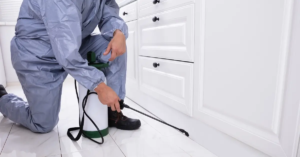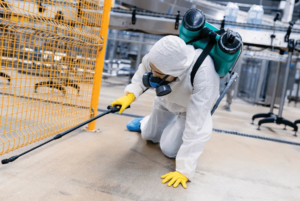Pest control involves managing the harmful actions of organisms to limit their impact on humans, other animals and plants. It includes monitoring and applying treatments, such as weed killers, to reduce pest numbers.
Accurate pest identification is the first step to developing a good pest management strategy. This helps determine whether a pest can be tolerated and when suppression is needed. It also determines the most appropriate control tactics and the best time to use them. Contact Pest Control Malibu now!

Pest identification is the first step in an integrated pest management program. Accurate identification enables a manager to gather important information about the pest such as where it lives, its life cycle, and how to control it.
In the case of stored product pests, correct identification can help prevent unnecessary use of costly chemicals. For example, a manager may be able to determine that pheromone traps are not the right solution if the pests are scurrying along skirting boards and other out-of-the-way places that humans do not frequent.
Whether the pest is an insect, plant disease or microbe, knowing what it is and how to control it will make the process much easier, cheaper and safer for everyone involved. Pests that are not controlled or eradicated can damage property, hurt people or pets and cause other problems.
Many pests live and seek shelter in dark, secluded and hard-to-inspect areas such as behind equipment and furnishings. A flashlight and an extendable mirror can help inspectors find harborage sites and confirm the presence of pests by observing feces, frass (excrement) and other evidence. Inspectors should also carry a magnifying lens to aid in pest identification.
Whenever possible, key pests should be identified to the species level. This enables the collection of additional important information about the pest such as its life cycle and behavior, and the factors that influence its development or abundance. It will also enable the selection of more targeted management strategies that minimize injury to beneficial organisms.
If the pest cannot be identified, contact your local County Extension agent or a pest control professional for assistance. They can provide you with an accurate diagnosis and recommend the best course of action.
If you need further assistance with identifying your mystery pest, the entomologists at Museums Victoria offer an online Identification Service. Simply provide a photo of your specimen and a brief description and they will send you the results via email within two hours. Please note that there is a fee associated with this service.
Prevention
Pest control is about controlling the presence of pests in a way that minimises risk to humans. This can be achieved through prevention, suppression or eradication. It also involves taking account of the role that pests play in ecosystems. For example, certain types of pests are important parts of natural food chains and habitats. Therefore, even though we don’t like them in our homes or retail and food preparation environments, they may need to remain at a level that we can tolerate.
The best form of pest control is prevention. This is accomplished by monitoring for signs of pests, identifying and correcting the conditions that allow them to flourish, and implementing structural preventive measures. Structural prevention includes things such as sealing cracks and crevices, caulking gaps, and reducing moisture levels. It also entails cleaning practices that do not invite pests, including regularly emptying garbage receptacles and sanitizing storage areas.
Other preventive measures include establishing a protocol for staff to follow when inspecting incoming shipments, defining who is responsible on client sites for removing garbage from locker room areas, and determining who is responsible for reporting building maintenance issues to pest management professionals. Establishing clear lines of responsibility and accountability can help ensure that pest control is a team effort.
It Saves Money on Future Treatments
Preventive measures reduce the need for repeated treatments, and they can be more effective than the use of chemical pesticides. However, chemicals are often needed to treat severe or enduring infestations. When this is the case, pest control specialists can offer targeted, focused applications that are as efficient as possible.
When used correctly, pesticides can be very effective and pose minimal risk to human health. It is essential to always read and follow pesticide labels and safety warnings. Ideally, pesticides should be targeted only at the specific organism being controlled and should be used in ways that minimize exposure to other species of insects or animals.
Some pesticides are designed to be highly selective, and they do not harm other organisms unless they are part of the target population. Other pesticides, however, are more generalized and can result in non-target harm, including poisoning birds that eat dead pests or other insects that have come into contact with the chemical.
Suppression
Pest suppression is a common method of controlling pests once they’ve invaded crops and landscapes. It involves specific tools that are used to reduce the number of pests by causing injury or otherwise disrupting the insects’ reproduction or feeding. Suppression tactics can include trapping, insecticidal sprays or a variety of pathogen treatments. It’s usually incorporated into preventative and eradication pest control services and is typically done as part of an ongoing maintenance plan around homes.
Many growers and green industry professionals are interested in using alternative, environmentally friendly control tactics to replace chemical pesticides. These options can be used for insects, weeds, plant-parasitic nematodes and other soil pathogens. While these methods can be effective, it’s important to understand their limitations and how they relate to the larger system that they are working within.
Some natural enemies have been intentionally introduced into cropland as a form of biological control, while others have arrived by chance. For example, native predatory birds and fish may take up an invasive pest as a new food source. Additionally, native parasitoids can sometimes take up a new host after consuming the previous one. In these cases, the natural enemy may provide a complementary or even a synergistic effect to control the pest.
Biological control agents can also be delivered as “inundative” releases, where large numbers are released to quickly overwhelm and suppress the pest population. This is a less labor-intensive option than collecting, breeding, raising and releasing natural enemies on your own. However, it’s important to monitor for the presence of the natural enemy after a suppression tactic has been implemented in order to make sure that the pest population has not rebounded to pre-treatment levels.
Fungi are also a form of natural enemy that can be used to control pests in some instances. Like bacteria, fungi spread through spores that can be delivered to an insect pest through direct contact or by airborne particles. The fungi then germinate inside the pest and develop special structures that penetrate into and kill the insect. Unlike bacteria, which can affect a wide range of insects, most fungi are species-specific and only attack the pests to which they are adapted.
Eradication
The goal of eradication is to reduce pest populations to such low levels that they no longer pose an economic threat. Eradication methods include extermination, extirpation, and uprooting. Exterminate refers to the total destruction of a pest, while extirpation describes driving a pest to extinction within an area. Uprooting implies forcibly removing a pest from a location, but not always killing it. Eradication is often a last resort when other pest control measures have failed.
Using pesticides to kill or control pests can be risky. If a pest develops resistance to a particular pesticide, the pesticide will no longer be effective. To avoid the development of pesticide resistance, it is important to use only a small amount of any pesticide and to apply it as directed on the product label. If a pesticide application fails, it may be because the pest was not identified correctly and a suitable pesticide was not selected or applied correctly. Using multiple pest control strategies and rotating them can also help to prevent the evolution of pesticide resistance.
Farmers have largely abandoned the old “crop insurance” approach of spraying everything in sight as soon as any sign of a pest shows up, and have learned to monitor pests carefully and quickly react to infestations with preventive and suppression methods. They have also reduced their overall pesticide usage, since they only spray when the benefits of doing so outweigh the costs.
In closed environments such as dwellings, schoolyards, office buildings, and health care facilities, prevention and suppression are usually the only pest management goals. Enclosing these areas with barriers that prevent pests from entering or breeding can be a costly and time-consuming project, but it can be a successful way to keep pest numbers down. Some examples of pest exclusion include installing screens, caulking cracks, and sealing leaky pipes. Adding a material such as boric acid (Figure 3) to insulation can help eliminate pests by preventing them from gaining access to the food they need. Keeping work and storage areas clean and sterilizing tools can also limit the opportunities for pests to find food or water sources.

